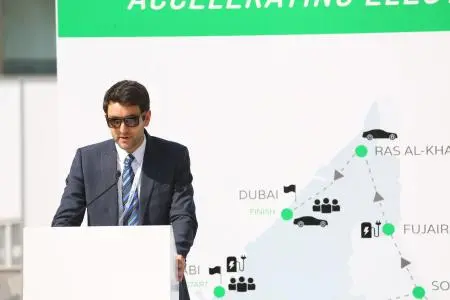PHOTO
Day Four News Highlights
- Emirates Electric Vehicle Road Trip to launch 18 permanent charging stations
- UAE on verge of mainstream low emission vehicle, say panellists
- Masdar and BNEF launch joint report on future of transport
Abu Dhabi, UAE: The World Future Energy Summit and its co-located events came to a close today, with a significant focus on the future of mobility and clean transport. Day four saw the launch of the first edition of the Mobility Conference, part of the World Future Energy Summit, reflecting the local and global attention on the changing automotive industry.
Electric Vehicle Road Trip kicks off from World Future Energy Summit
Launched by H.E. Eng. Suhail Mohamed Faraj Al Mazrouei, UAE Minister of Energy and Industry, the Emirates Electric Vehicle Road Trip set off today from the World Future Energy Summit, marking the start of an all-electric journey from Abu Dhabi to Oman.
The convoy, which includes some of the latest electric vehicle models, will open more than 18 permanent charging stations along the way. The journey, totaling some 1,217 kilometres, will last nine days, all without using a single drop of petrol.
Ben Pullen, Founder and CEO of Global EVRT, said: “The Electric Vehicle market has developed significantly in the last 12 months and it’s fantastic to be part of WFES discussing the future of mobility and finding innovative and sustainable solutions today, including the work from GreenParking, who are building charging stations at IHG hotels in Abu Dhabi and beyond.”
“Over the next nine days, we will also be showcasing the region’s stunning scenery, as well as the efforts to promote sustainability, offering the public the chance to test the vehicles for themselves and experience the capabilities of the technology that is shaping the future of transport, including the first ever petrol vs EV drag race and a kids’ electric vehicle race as part of our trip.”
Mobility conference outlines plans to bring electric vehicles to the mainstream
The mobility conference launched today with a panel discussion surrounding the strategies and opportunities for mass-market adoption of low emission vehicles in the UAE.
Speaking ahead of the panel discussion, Michael Liebriech, Founder of Bloomberg New Energy Finance, discussed some of factors surrounding the uptake of low emission vehicles. With unsubsidized solar power and renewable energy costs now costing as little as 2 cents per kilowatt hour, the energy industry will be able to cater to the increase in supply needed for the mainstream adoption of electric vehicles, he explained.
Fares Al Mazrooei, Co-Founder and Managing Director of Volt, highlighted that charging infrastructure remains an issue in the UAE, as well as the need for further incentives to attract the consumer market towards electric vehicles.
Ismail Sethi, Regional Product Marketing Manager for SUV, Cossovers and Electric Vehicles at Nissan, said: “Electrification is not only the future, it is the present. As the world’s leading EV manufacturer, we have sold more than 280,000 Nissan LEAFs globally, making it the world’s best-selling electric vehicle. LEAF customers have driven more than 3.5 billion zero-emission kilometers combined. As global leaders in electric vehicles we are committed to contributing to the success of electric vehicles in the UAE, and believe the ambitious plans set out by the government will be met.”
Experts Discuss Report on Technologies for Future Smart City Transit
Steve Severance, Head of Program Management and Investments at Masdar City, moderated a panel discussion on the findings of a new report titled “The Masdar Report on Technologies for Future Smart City Transit”. He was joined by Christian Leborgne, Chief Operations Officer at Navya, and Ali Izad-Najafabadi, Head of Intelligent Mobility at Bloomberg New Energy Finance.
Building on the report’s findings, panelists discussed the central role of reference data, noting that the roll-out of 5G mobile technology will expedite the progress of next-generation mobility. The panel also explained that geofencing processes, which are important to implementing fully autonomous vehicles in the mass-market, require large amounts of data.
The report addresses the intersection of emerging technologies – from electric and autonomous vehicles and “smart roads” to the Internet of Things and blockchain – that will provide the building blocks to revolutionise urban transport over the next two decades. These technologies are converging at the same time, putting the mobility sector on the cusp of a significant leap forward that will improve efficiency, save lives and reduce pollution.
Global Clean Water Desalination Alliance
On the final day of the International Water Summit, the Global Clean Water Desalination Alliance (GCWDA) hosted a panel discussion to provide an overview on the GCWDA and its commitment to present roadmaps for clean water desalination in the UAE and in selected island nations. The session also highlighted available technologies for clean water desalination and future desalination needs.
The panel was moderated by Fatima Al Suwaidi, GCWDA Secretariat, Masdar and was joined by leading experts in water desalination and renewable energy including Leon Awerbuch, Director of the Desalination Academy, International Desalination association.
We Need to Manufacture More Building Off-site and Assemble On-site”, Expert Tell Energy Efficiency Conference
At today’s Energy Efficiency in Buildings Forum, Gerard Evenden, Executive Senior Partner - Foster + Partners, delivered a presentation on energy and water efficiency in buildings and how the different aspects of sustainability in urban environments fit together.
During the presentation, Evenden told his audience that the construction industry is still creating buildings in the stone age and ignoring the ability to manufacture offsite and erect onsite. He went on to provide an example of Foster and Partners’ work in Dubai, where it has started to look at the new Design District in the city. There, a framework environment is created which provides a basic modular system and that system can be adapted and changed as the inhabitants move in. Of course, all of this is designed for deconstruction, so it is all prefabricated off site and assembled onsite.
-Ends-











